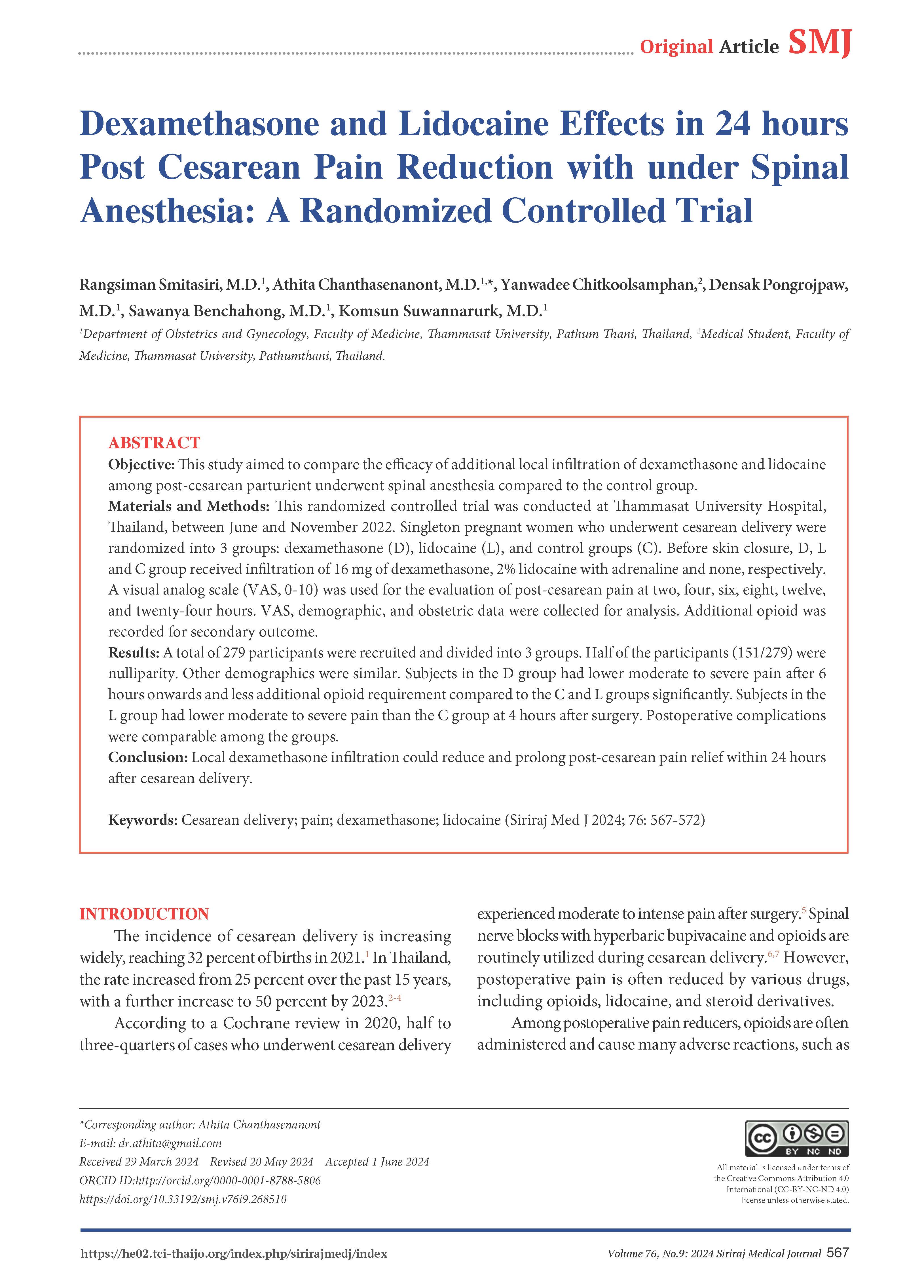Dexamethasone and Lidocaine Effects in 24 hours Post Cesarean Pain Reduction under Spinal Anesthesia: A Randomized Controlled Trial
DOI:
https://doi.org/10.33192/smj.v76i9.268510Keywords:
Cesarean delivery, Pain, Dexamethasone, LidocaineAbstract
Objective: This study aimed to compare the efficacy of additional local infiltration of dexamethasone and lidocaine among post-cesarean parturient underwent spinal anesthesia compared to the control group.
Materials and Methods: This randomized controlled trial was conducted at Thammasat University Hospital, Thailand, between June and November 2022. Singleton pregnant women who underwent cesarean delivery were randomized into 3 groups: dexamethasone (D), lidocaine (L), and control groups (C). Before skin closure, D, L and C group received infiltration of 16 mg of dexamethasone, 2% lidocaine with adrenaline and none, respectively. A visual analog scale (VAS, 0-10) was used for the evaluation of post-cesarean pain at two, four, six, eight, twelve, and twenty-four hours. VAS, demographic, and obstetric data were collected for analysis. Additional opioid was recorded for secondary outcome.
Results: A total of 279 participants were recruited and divided into 3 groups. Half of the participants (151/279) were nulliparity. Other demographics were similar. Subjects in the D group had lower moderate to severe pain after 6 hours onwards and less additional opioid requirement compared to the C and L groups significantly. Subjects in the L group had lower moderate to severe pain than the C group at 4 hours after surgery. Postoperative complications were comparable among the groups.
Conclusion: Local dexamethasone infiltration could reduce and prolong post-cesarean pain relief within 24 hours after cesarean delivery.
References
Betran AP, Ye J, Moller AB, Souza JP, Zhang J. Trends and projections of caesarean section rates: global and regional estimates. BMJ Glob Health. 2021;6(6):e005671.
Royal Thai College of Obstetricians and Gynaecologists. Position statement for cesarean section (Revised version 2023) [Internet]. 2023 [cited 2022 NOV 15]. Available form: https://www.rtcog.or.th/news/view/54.
Phadungkiatwattana P, Tongsakul N. Analyzing the impact of private service on the cesarean section rate in public hospital Thailand. Arch Gynecol Obstet. 2011;284(6):1375-9.
Chanthasenanont A, Pongrojpaw D, Nanthakomon T, Somprasit C, Kamudhamas A, Suwannarurk K. Indications for cesarean section at Thammasat University Hospital. J Med Assoc Thai. 2007;90(9):1733-7.
Zimpel SA, Torloni MR, Porfírio GJ, Flumignan RL, da Silva EM. Complementary and alternative therapies for post-caesarean pain. Cochrane Database Syst Rev. 2020;9:CD011216.
Ferrarezi WPP, Braga AFA, Ferreira VB, Mendes SQ, Brandão MJN, Braga FSDS, et al. Spinal anesthesia for elective cesarean section. Bupivacaine associated with different doses of fentanyl: randomized clinical trial. Braz J Anesthesiol. 2021;71(6):642-8.
Cunningham FG, Leveno KJ. Obstetrical Analgesia and Anesthesia. In: Cunningham FG, Leveno KJ, Bloom SL, editors. Williams obstetrics. 26th ed. New York: McGraw Hill Education; 2022.p.467-85.
Carvalho B, Butwick AJ. Postcesarean delivery analgesia. Best Pract Res Clin Anaesthesiol. 2017;31(1):69-79.
Bai JW, An D, Perlas A, Chan V. Adjuncts to local anesthetic wound infiltration for postoperative analgesia: a systematic review. Reg Anesth Pain Med. 2020;45(8):645-55.
Boonyapalanant C, Woranisarakul V, Jitpraphai S, Chotikawanich E, Taweeemonkongsap T, Bahadur H, et al. The Efficacy of Inside-Out Transversus Abdominis Plane Block vs Local Infiltration before Wound Closure in Pain Management after Kidney Transplantation: A Double-blind, Randomized Trial. Siriraj Med J. 2022;74:233-8.
Maged AM, Deeb WS, Elbaradie S, Elzayat AR, Metwally AA, Hamed M, et al. Comparison of local and intra venous dexamethasone on post operative pain and recovery after caesarean section. A randomized controlled trial. Taiwan J Obstet Gynecol. 2018;57(3):346-50.
Tharwat AA, Yehia AH, Wahba KA, Ali AE. Efficacy and safety of post-cesarean section incisional infiltration with lidocaine and epinephrine versus lidocaine alone in reducing postoperative pain: A randomized controlled double-blinded clinical trial. J Turk Ger Gynecol Assoc. 2016;17(1):1-5.
Vinycomb TI, Sahhar LJ. Comparison of local anesthetics for digital nerve blocks: a systematic review. J Hand Surg Am. 2014;39(4):744-51.e5.
Ituk U, Thenuwara K. The effect of a single intraoperative dose of intravenous dexamethasone 8 mg on post-cesarean delivery analgesia: a randomized controlled trial. Int J Obstet Anesth. 2018;35:57-63.
Kessous R, Wiznitzer A, Polachek H, Weintraub AY, Zlotnik A, Pariente G, et al. Preoperative analgesia with local lidocaine infiltration for post cesarean delivery pain management. J Matern Fetal Neonatal Med. 2012;25(7):1131-4.
Frey-Law LA, Lee JE, Wittry AM, Melyon M. Pain rating schema: three distinct subgroups of individuals emerge when rating mild, moderate, and severe pain. J Pain Res. 2013;7:13-23.
Kintu A, Abdulla S, Lubikire A, Nabukenya MT, Igaga E, Bulamba F, et al. Postoperative pain after cesarean section: assessment and management in a tertiary hospital in a low-income country. BMC Health Serv Res. 2019;19(1):68.
Henzi I, Walder B, Tramèr MR. Dexamethasone for the prevention of postoperative nausea and vomiting: a quantitative systematic review. Anesth Analg. 2000;90(1):186-94.
Holte K, Kehlet H. Perioperative single-dose glucocorticoid administration: pathophysiologic effects and clinical implications. J Am Coll Surg. 2002;195(5):694-712.
Gan TJ, Habib AS, Miller TE, White W, Apfelbaum JL. Incidence, patient satisfaction, and perceptions of post-surgical pain: results from a US national survey. Curr Med Res Opin. 2014;30(1):149-60.
Singh NP, Makkar JK, Yadav N, Goudra BG, Singh PM. The analgesic efficacy of intravenous dexamethasone for post-caesarean pain: A systematic review with meta-analysis and trial sequential analysis. Eur J Anaesthesiol. 2022;39(6):498-510.
De Oliveira GS Jr, Almeida MD, Benzon HT, McCarthy RJ. Perioperative single dose systemic dexamethasone for postoperative pain: a meta-analysis of randomized controlled trials. Anesthesiology. 2011;115(3):575-88.

Published
How to Cite
License
Copyright (c) 2024 Siriraj Medical Journal

This work is licensed under a Creative Commons Attribution-NonCommercial-NoDerivatives 4.0 International License.
Authors who publish with this journal agree to the following conditions:
Copyright Transfer
In submitting a manuscript, the authors acknowledge that the work will become the copyrighted property of Siriraj Medical Journal upon publication.
License
Articles are licensed under a Creative Commons Attribution-NonCommercial-NoDerivatives 4.0 International License (CC BY-NC-ND 4.0). This license allows for the sharing of the work for non-commercial purposes with proper attribution to the authors and the journal. However, it does not permit modifications or the creation of derivative works.
Sharing and Access
Authors are encouraged to share their article on their personal or institutional websites and through other non-commercial platforms. Doing so can increase readership and citations.














